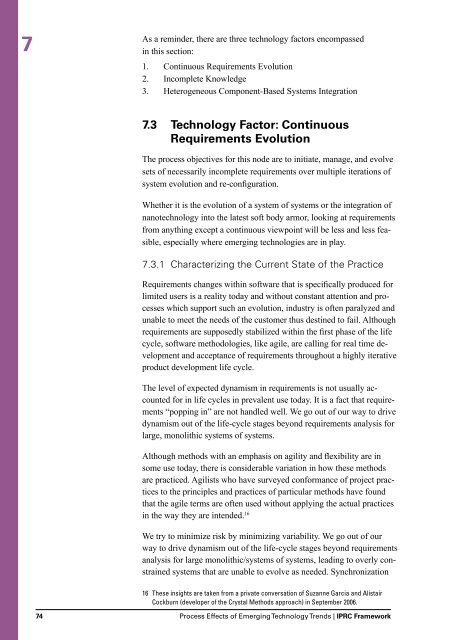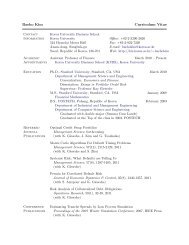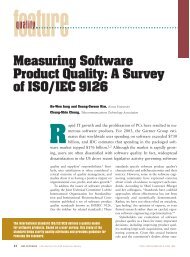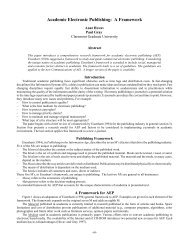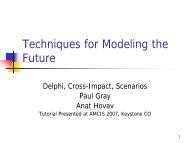A Process Research Framework - Software Engineering Institute ...
A Process Research Framework - Software Engineering Institute ...
A Process Research Framework - Software Engineering Institute ...
You also want an ePaper? Increase the reach of your titles
YUMPU automatically turns print PDFs into web optimized ePapers that Google loves.
7As a reminder, there are three technology factors encompassedin this section:1. Continuous Requirements Evolution2. Incomplete Knowledge3. Heterogeneous Component-Based Systems Integration7.3 Technology Factor: ContinuousRequirements EvolutionThe process objectives for this node are to initiate, manage, and evolvesets of necessarily incomplete requirements over multiple iterations ofsystem evolution and re-configuration.Whether it is the evolution of a system of systems or the integration ofnanotechnology into the latest soft body armor, looking at requirementsfrom anything except a continuous viewpoint will be less and less feasible,especially where emerging technologies are in play.7.3.1 Characterizing the Current State of the PracticeRequirements changes within software that is specifically produced forlimited users is a reality today and without constant attention and processeswhich support such an evolution, industry is often paralyzed andunable to meet the needs of the customer thus destined to fail. Althoughrequirements are supposedly stabilized within the first phase of the lifecycle, software methodologies, like agile, are calling for real time developmentand acceptance of requirements throughout a highly iterativeproduct development life cycle.The level of expected dynamism in requirements is not usually accountedfor in life cycles in prevalent use today. It is a fact that requirements“popping in” are not handled well. We go out of our way to drivedynamism out of the life-cycle stages beyond requirements analysis forlarge, monolithic systems of systems.Although methods with an emphasis on agility and flexibility are insome use today, there is considerable variation in how these methodsare practiced. Agilists who have surveyed conformance of project practicesto the principles and practices of particular methods have foundthat the agile terms are often used without applying the actual practicesin the way they are intended. 16We try to minimize risk by minimizing variability. We go out of ourway to drive dynamism out of the life-cycle stages beyond requirementsanalysis for large monolithic/systems of systems, leading to overly constrainedsystems that are unable to evolve as needed. Synchronization16 These insights are taken from a private conversation of Suzanne Garcia and AlistairCockburn (developer of the Crystal Methods approach) in September 2006.74 <strong>Process</strong> Effects of Emerging Technology Trends | IPRC <strong>Framework</strong>


